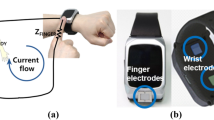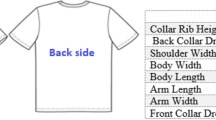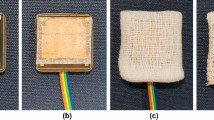Abstract
Background/Objectives:
Functional garments for physiological sensing purposes have been used in several disciplines, that is, sports, firefighting, military and medicine. In most of the cases, textile electrodes (textrodes) embedded in the garment are used to monitor vital signs and other physiological measurements. Electrical bioimpedance (EBI) is a non-invasive and effective technology that can be used for the detection and supervision of different health conditions.
EBI technology could make use of the advantages of garment integration; however, a successful implementation of EBI technology depends on the good performance of textrodes. The main drawback of textrodes is a deficient skin–electrode interface that produces a high degree of sensitivity to signal disturbances. This sensitivity can be reduced with a suitable selection of the electrode material and an intelligent and ergonomic garment design that ensures an effective skin–electrode contact area.
Subjects/Methods:
In this work, textrode functional straps for total right side EBI measurements for body composition are presented, and its measurement performance is compared against the use of Ag/AgCl electrodes. Shieldex sensor fabric and a tetra-polar electrode configuration using the ImpediMed spectrometer SFB7 in the frequency range of 3–500 kHz were used to obtain and analyse the impedance spectra and Cole and body composition parameters.
Results:
The results obtained show stable and reliable measurements; the slight differences obtained with the functional garment do not significantly affect the computation of Cole and body composition parameters.
Conclusions:
The use of a larger sensor area, a high conductive material and an appropriate design can compensate, to some degree, for the charge transfer deficiency of the skin–electrode interface.
This is a preview of subscription content, access via your institution
Access options
Subscribe to this journal
Receive 12 print issues and online access
$259.00 per year
only $21.58 per issue
Buy this article
- Purchase on Springer Link
- Instant access to full article PDF
Prices may be subject to local taxes which are calculated during checkout






Similar content being viewed by others
References
Lymberis A, Dittmar A . Advanced wearable health systems and applications—research and development efforts in the European union. Eng Med Biol Mag IEEE 2007; 26: 29–33.
Paradiso R, De Rossi D . Advances in textile sensing and actuation for e-textile applications. Conf Proc IEEE Eng Med Biol Soc 2008; 2008: 3629.
Hännikäinen J, Vuorela T, Vanhala J . Physiological measurements in smart clothing: a case study of total body water estimation with bioimpedance. Trans Inst Measure Control 2007; 29: 337–354.
Vuorela TJH, Vähäkuopus K, Vanhala J (eds). Textile electrode usage in a bioimpedance measurement. The First International Scientific Conference on Intelligent Ambience and Well-Being. Talvenmaa, P Ambience 05: Tampere, Finland, 2005.
Amft O, Habetha J . Smart medical textiles for monitoring patients with heart conditions. In: Van Langenhove L (ed). Smart Textiles for Medicine and Healthcare Materials, Systems and Applications. Woodhead Publishing Limited: Cambridge, England, 2007, pp 275–301.
Paradiso R, De Rossi D (eds). Advances in textile technologies for unobtrusive monitoring of vital parameters and movements. Engineering in Medicine and Biology Society, 2006. EMBS ’06. 28th Annual International Conference of the IEEE 2006: New York.
Paradiso R, Loriga G, Taccini N Wearable health care system for vital signs monitoring. MEDICON; Naples, 2004.
Agarwal R, Yadav R, Anand S, Suri JC, Girija J . Electrical impedance plethysmography technique in estimating pulmonary function status. J Med Eng Technol 2007; 31: 1–9.
Azar R, Al-Moubarak I, Barsumau J, Smessaert C, Vairon MX . Assessment and follow-up of nutritional status in hemodialysis patients. Nephrol Ther 2009; 5 (Suppl 5), S317–S322.
Kushner RF, Schoeller DA . Estimation of total body water by bioelectrical impedance analysis. Am J Clin Nutr 1986; 44: 417–424.
Medrano G, Eitner F, Floege J, Leonhardt S . A novel bioimpedance technique to monitor fluid volume state during hemodialysis treatment. Asaio J 2010; 56: 215–220.
Marquez JC, Seoane F, Välimäki E, Lindecrantz K . Comparison of dry-textile electrodes for electrical bioimpedance spectroscopy measurements. In: Rosalind (ed) ICEBI2010. IOP: Gainesville, 2010.
Marquez JC, Ferreira J, Seoane F, Buendia R, Lindecrantz K . Textile electrode straps for wrist-to-ankle bioimpedance measurements for body composition analysis. Initial validation and experimental results. Conference Proceedings of the IEEE Engineering in Medicine & Biology Society. Buenos Aires, Argentina, 2010, pp. 6385–6388.
Medrano G, Beckmann L, Zimmermann N, Grundmann T, Gries T, Leonhardt S . Bioimpedance spectroscopy with textile electrodes for a continuous monitoring application. In: Leonhardt S, Falck T, Mähönen P (eds) 4th International Workshop on Wearable and Implantable Body Sensor Networks (BSN 2007). Springer: Berlin, Heidelberg, 2007, pp. 23–28.
Beckmann L, Neuhaus C, Medrano G, Jungbecker N, Walter M, Gries T et al. Characterization of textile electrodes and conductors using standardized measurement setups. Physiol Meas 2010; 31: 233.
Matthie JR . Bioimpedance measurements of human body composition: critical analysis and outlook. Expert Rev Med Devices 2008; 5: 239–261.
Cole KS . Permeability and impermeability of cell membranes for ions. Quant Biol 1940; 8: 110–122.
De Lorenzo A, Andreoli A, Matthie J, Withers P . Predicting body cell mass with bioimpedance by using theoretical methods: a technological review. J Appl Physiol 1997; 82: 1542–1558.
Van Loan MD, Withers P, Matthie J, Mayclin PL . Use of bioimpedance spectroscopy to determine extracellular fluid, intracellular fluid, total body water, and fat-free mass. Basic Life Sci 1993; 60: 67–70.
Buendia R, Seoane F, Gil-Pita R . Novel approach for removing the hook effect artefact from electrical bioimpedance spectroscopy measurements. J Phys: Conf Ser 2010; 224: 121–126.
Grimnes S, Martinsen Ø Bioimpedance and Bioelectricity Basics 2nd edn. Academic Press: Great Britain, 2008.
Marquez JC, Seoane F, Lindecrantz K (eds).. Skin-electrode contact area in electrical bioimpedance spectroscopy. Influence in total body composition assessment. Conference Proceedings of the IEEE Engineering in Medicine & Biology Society. Boston, USA, 2011.
Bogonez-Franco P, Nescolarde L, Bragos R, Rosell-Ferrer J, Yandiola I . Measurement errors in multifrequency bioelectrical impedance analyzers with and without impedance electrode mismatch. Physiol Meas 2009; 30: 573–587.
Kraemer M, Rode C, Wizemann V . Detection limit of methods to assess fluid status changes in dialysis patients. Kidney Int 2006; 69: 1609–1620.
Kushner RF, de Vries PM, Gudivaka R . Use of bioelectrical impedance analysis measurements in the clinical management of patients undergoing dialysis. Am J Clin Nutr 1996; 64 (3 Suppl), 503S–509SS.
Dumler F . Use of bioelectric impedance analysis and dual-energy X-ray absorptiometry for monitoring the nutritional status of dialysis patients. Asaio J 1997; 43: 256–260.
Hallin R, Janson C, Arnardottir RH, Olsson R, Emtner M, Branth S et al. Relation between physical capacity, nutritional status and systemic inflammation in COPD. Clin Respir J 2011; 5: 136–142.
Lerario MC, Sachs A, Lazaretti-Castro M, Saraiva LG, Jardim JR . Body composition in patients with chronic obstructive pulmonary disease: which method to use in clinical practice? Br J Nutr 2006; 96: 86–92.
Walter-Kroker A, Kroker A, Mattiucci-Guehlke M, Glaab T . A practical guide to bioelectrical impedance analysis using the example of chronic obstructive pulmonary disease. Nutr J 2011; 10: 35.
Buffa R, Mereu RM, Putzu PF, Floris G, Marini E . Bioelectrical impedance vector analysis detects low body cell mass and dehydration in patients with Alzheimer's disease. J Nutr Health Aging 2010; 14: 823–827.
Lof M, Forsum E . Evaluation of bioimpedance spectroscopy for measurements of body water distribution in healthy women before, during, and after pregnancy. J Appl Physiol 2004; 96: 967–973.
Acknowledgements
This work was supported in part by the Mexican CONACYT under Scholarship 304684. Publication of this article was supported by a grant from seca Gmbh & Co. KG, Hamburg, Germany. All the test subjects gave informed consent to participate in the study, in agreement with the ethical approval nr 274-11 granted by the regional ethical review board in Gothenburg.
Author information
Authors and Affiliations
Corresponding author
Ethics declarations
Competing interests
FSM is part owner of Z-Health Technologies AB. KL has equity ownership or stock options in Z-Health Technologies AB. JCM declare has no conflict of interest.
Rights and permissions
About this article
Cite this article
Márquez, J., Seoane, F. & Lindecrantz, K. Textrode functional straps for bioimpedance measurements-experimental results for body composition analysis. Eur J Clin Nutr 67 (Suppl 1), S22–S27 (2013). https://doi.org/10.1038/ejcn.2012.161
Published:
Issue Date:
DOI: https://doi.org/10.1038/ejcn.2012.161



